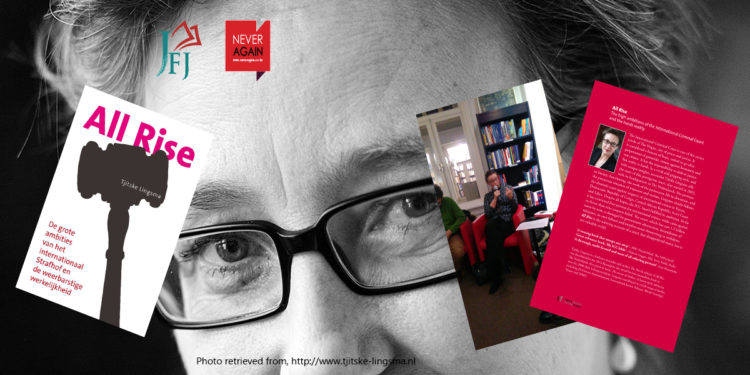Award-winning journalist and author Tjitske Lingsma has closely followed events at the International Criminal Court (ICC) as it took on cases in Kenya, the Democratic Republic of Congo, Central African Republic, Ivory Coast and Libya. Her book, All Rise: The high ambitions of the International Criminal Court and the harsh reality, released in English in September 2017 is a searing examination of the court’s performance, and the hopes for the future as it marks its 20th anniversary next year.
Journalists for Justice launches a two-part serialization of the book variously described by critics as ‘rousing’, ‘thorough’ and ‘a sobering portrait’ of the ICC.
The uproar in the Kenyan Parliament is still resonating when the big day arrives. With a sky of dark grey clouds above the ICC, the trial against Ruto and Sang starts on 10 September 2013 – half a year after the deputy president has been elected in office. Again dozens of members of parliament, representatives of human rights organisations, diplomats and other ICC watchers go up to the public gallery. The international and Kenyan media have turned out as well. For the first time in the history of inrernation.al criminal tribunals and courts a deputy president in active service is on trial. Ruto is not a pariah, not a defeated militia leader who is on the run or has been languishing in prison. Ruto is a popular, rich and influential government leader.
It was quite a conundrum for the host state – The Netherlands – to decide how to receive the defendant, a source disclosed. At the ministry of foreign affairs there was great reluctance to apply the full diplomatic protocols, as Ruto was not visiting the country as deputy president, but as a suspect of international crimes. The Kenyan government was however expecting nothing less than first class diplomatic treatment. Apparently some halfway solution was found, between politely handling the delegation while not providing a full official motorcade. Two women take the front seats on the left of the public gallery, as close as possible to the deputy president and his defence team. Rachel Ruto and daughter June have come along to support their husband and father. Next to them sits the Kenyan ambassador, who explained during a press briefing any earlier, that the trials harm Kenya and are a logistical nightmare for her embassy as well. Her staff is working night a nd day to make all the necessary arrangements for the suspects and their supporters who a re travelling with them. Sitting in the dock, dressed in a nice grey suit a nd a red tie, Ruto smiles a t his family.
The nation’s leader is the absolute eye-catcher. His co-accused, Joshua Sang, not only sits further away, but is such a short man that, while seated in a chair, he can barely see the desk. Presiding judge Chile Eboe-Osuji opens the hearing.-The Nigerian law expert, a man with a distinct heavy voice and an impressive CV with previous posts such as legal advisor to the UN High Commissioner for Human Rights, head legal affairs for the judges of the Rwanda Tribunal, counsel with the prosecution at the Special Court for Sierra Leone and a PhD from the University of Amsterdam, starts to speak. With visible delight he will guide the trial, assisted by two fellow judges. (Trendafilova is a judge with the section that handles cases in the pre-trial phase; but when cases enter the trial phase another set of judges oversees these proceedings). After an introduction describing the history of the case, Eboe-Osuji addresses the Kenyan deputy president.
‘Mr Ruto, please rise to take your plea. William Samoei Ruto, you have been charged in count 1 with murder, constituting a crime against humanity,’ he says. ‘How do you plead, guilty or not guilty?’ ‘Not guilty,’ Ruto answers with a remarkably soft voice.’ In count 2 you have been charged with deportation or forcible transfer of population,’
the judge continues. ‘How do you plead, guilty or not guilty?’ ‘Not guilty.’ ‘In count 3 you have been charged with persecution.’ ‘Not guilty.’ ‘Thank you very much. You may resume your seat,’ says the judge, who then turns to Sang.· The broadcaster – facing the same charges – will also plead ‘not guilty.’ As the driving force behind the trial, prosecutor Bensouda is given the floor to start with her opening statement. ‘It is difficult to imagine the suffering or the terror of the men and the women and children who were burned alive, hacked to death, or chased (from their homes by armed youths,’ she recalls the violence that erupted after the elections of December 2007. While Bensouda describes the terrible-fate of ordinary citizens, the suspects listen carefully to her address. But when she refers to Ruto and ‘his syndicate of powerful allies,’ the deputy president is given a note by one of his lawyers and starts to laugh. Undisturbed the prosecutor continues her statement.
Bensouda tells how Ruto allegedly planned and organised the violence to ‘satisfy his thirst for political power.’ Eighteen months before the elections, he had started building a criminal organisation consisting of community leaders, former military, businessmen and media. Ruto played the key role. He ‘assigned responsibilities, he raised finance, he procured weapons and hosted meetings in furtherance of the criminal aims of the network,’ Bensouda says. He used the social structure of his ethnic group and gathered ‘an army of loyal Kalenjin youth to go to war for him in the event of an election loss.’ The main target were the Kikuyu, as they were perceived ‘the unwelcome settlers who had misappropriated what the Kalenjin considered to be their ancestral land.’
The prosecutor accuses Ruto of stoking ‘the flames of anti-Kikuyu sentiment, both personally at public rallies and indirectly through other influential speakers and through the media.’ So when the election was lost, Ruto ‘gave the order to attack,’ Bensouda tells the court. Broadcaster Sang, who was the ‘main mouthpiece’, placed his ‘prime-time radio show at the disposal of the network.’ He not only spread the word of Ruto’s rallies, but even helped to coordinate attacks through ‘coded’ messages. ‘In this way, he too contributed to the violence,’ the prosecutor explains. A security guard walks to the first rows of the public gallery where a Kenyan man seems to have fallen asleep. Other visitors chuckle when the guard taps the person on his shoulder and explains it is not allowed to have a nap. The man isn’t impressed and remains in the same position. Surprisingly the guard leaves it at that. Usually the security personnel is strict in applying rules of order and decorum.
ALSO READ: Book serialisation: Hopes, triumphs and failures at the ICC (Part 2)
The prosecutor points out that it wouldn’t even have been necessary for the ICC to deal with this case. In fact, her office had waited a long time to see whether Kenya would take steps to prosecute the perpetrators itself. She underlines that during the violence Kofi Annan had been sent to Kenya to try to end the conflict through mediation.
The former secretary general of the United Nations and chair of the AU’s Panel of Eminent African Personalities, had managed to strike a power-sharing deal between the parties Part of the agreement was the installation of an investigative body. This Commission of inquiry on Post-Election Violence (CIPEV), led by the Kenyan judge Philip Waki, made an analysis of the conflict. In its final report, published on 15 October 2008, the commission came with an urgent recommendation to the Kenyan authorities to set up a special national tribunal to prosecute those responsible for the political violence between 2007 and 2008.
The CIPEV had produced a confidential list with names of suspects {later it was revealed that Ruto’s name was on it), but Waki didn’t disclose the names publicly. He gave the records in a sealed envelope to Kofi Annan, in an effort to keep the pressure on the government to set up the tribunal. In July 2009 Annan handed over the list to prosecutor Moreno Ocampo – together with several boxes full of investigative material that the commission had assembled during its inquiry. When no national tribunal was being set up, it was clear that Kenya was not willing to initiate prosecutions.
So Moreno-Ocampo took steps to start these himself. On 5 November 2009 he notified the president of the ICC that he would ask for authorization to open investigations – ‘a decision which was fully supported at the time by the Kenya government,’ says Bensouda. In other words, the Kenyan leaders owed it to themselves that a trial was now taking place in The Hague. (The suspects had requested the ICC to move hearings to Kenya or Tanzania, but by a tiny majority the judges rejected that option during a plenary session in July 2013. It was deemed too expensive, cumbersome, logistically complex and too unsafe for victims, witnesses and even for ICC staff to hold part of the trials in these countries. It hasn’t been easy for her office to handle this case, Bensouda explains to the judges. Cooperation with Kenya is problematic.
Many witnesses and victims are too scared to talk. Others who have given testimony face such heavy intimidation that out of fear they have been pulling out. There are persons who have been offered bribes to force them to change their statements or withdraw. The very fact, Mr President, that I stand before you at the .opening of this trial today, your Honours, is something of an achievement in itself,’ Bensouda says before issuing a warning to ‘those persons behind the ongoing attempts to intimidate and bribe the ICC witnesses: these are serious offences under the Rome Statute and they face hefty sentences upon conviction. The OTP is investigating these sign of witness interference and her office will ge t to the bottom of it, the prosecutor warns.
Bensouda is coming to the conclusion of her statement. ‘This is not of trial of Kenya or of the Kenyan people. It is not about vindicating or indicting one or other ethnic group or political party. It is not about meddling in African affairs. 1his trial, Mr President, your Honours, is about obtaining justice for the many thousands of victims of the post-election violence and ensuring that there is no impunity for those responsible, regardless of power or position.’ Then she hands over to Anton Steynberg, lead counsel for the prosecution, who will explain in more detail the structure behind the violence.
Ruto’s network wasn’t an official military or government organisation, he stresses. Steynberg: ‘It did not have formal ranks, offices, or letters of appointment.
It did not keep formal records in the form of cabinet minutes, nor did it report its activities via military situation reports. Rather, this network was a criminal organisation in the style of a mafia group or a triad organisation.’ This didn’t mean that it was less organised. ‘It had a clear hierarchy and chain of command, with Mr Ruto at the apex,’ the lead counsel explains. The suspect used his ‘political and tribal authority and the tradition of obedience of the Kalenjin to their leaders.’ The ultimate goal was: ‘to rid the Rift Valley of its political and ethnic opponents.’ The political component of the network was formed by prominent politicians and community leaders. The money was provided by Kalenjin businessmen and Ruto himself, and used for implementing the common plan, ‘handing out cash to those who attended meetings and pledging rewards to those who killed perceived PNU supporters or destroyed their properties. ‘Militarily the network included former servicemen who coordinated attacks, while divisional leaders were leading ‘thousands of Kalenjin youth’ who committed the actual violence.
Traditional leaders were calling their followers to attend preparatory meetings. 1hey ‘exploited traditional circumcision and oathing ceremonies of Kalenjin youth in order to indoctrinate and train large numbers of warriors before the elections,’ Steynberg tells the court. To those who refused to participate; – the traditional leaders meted out punishments which included public humiliation, flogging and forcing them to pay penance in livestock, some of which were used to feed warriors on the ground.’ After the violence the traditional leaders ‘performed cleansing ceremonies’ to absolve youth of any crimes they had committed.
The OTP had found out that the operations had started back in 2006, during a first meeting with a small group of confidants in Ruto’s house in Sugoi, on the outskirts of the city of Turbo, in the west of the country. In advance of the elections the organisation would have the complete logistics ready to go to war: leaders, sponsors, perpetrators, money, weapons, transport, food and communication. During the attacks houses and companies were looted. ‘Kikuyu who were found, were caught and attacked on sight, with weapons such as arrows, or pangas, and many were killed or gravely injured.’ How many witnesses the prosecution plans to call remains unclear.
The list is confidential for the public- also because witnesses keep dropping out. The only specific number Steynberg wants to give is that the prosecution will present up to 22 victims who will come to testify. They are common Kenyan people who will describe what happened during the attacks, and so experts will testify. But Steynberg remains silent about the insiders, who were part of the alleged criminal network, possibly were perpetrators themselves and have knowledge about what happened in the organisation. Prosecutors usually need these witnesses to bring cases to a conviction. Several Kenyan insiders are said to be included in the ICC’s witness protection programme and are residing in safe houses abroad. Steynberg does have a message to witnesses who suddenly change their minds and desert the prosecution’s camp to join Ruto’s defence. ‘The prosecution will, if necessary, present evidence as to the true motives behind their actions, and that is, that they have been bribed to do so.’
All Rise is published by Ipso Facto (Second Edition, June 29, 2017), pp: 448. Reproduction of this excerpt is NOT permitted unless with the author’s written permission.






